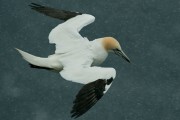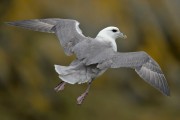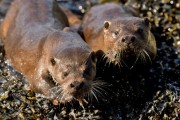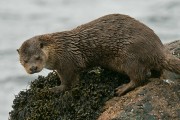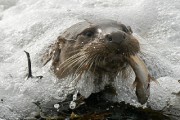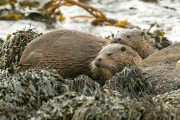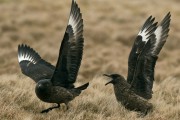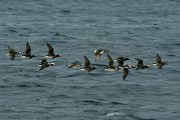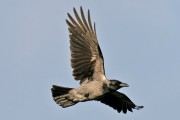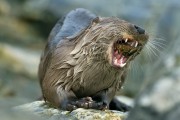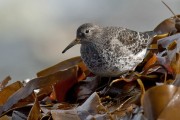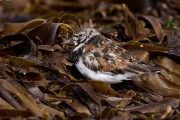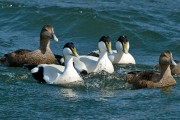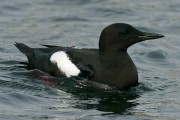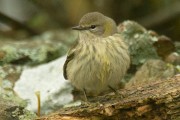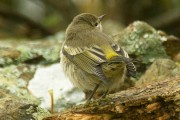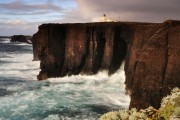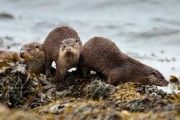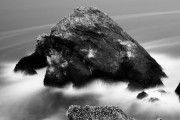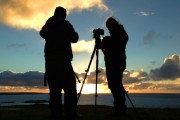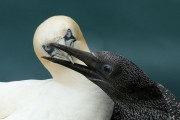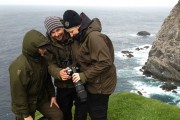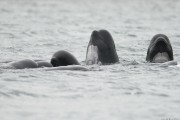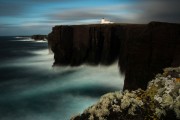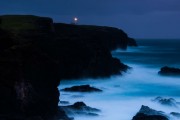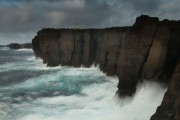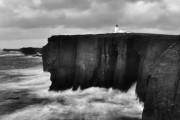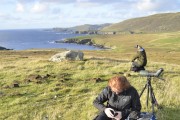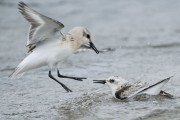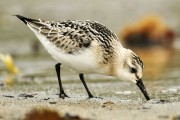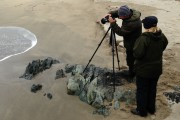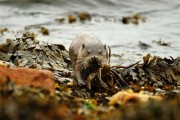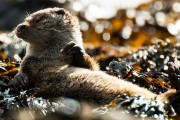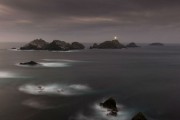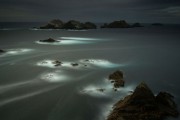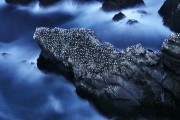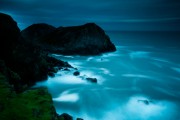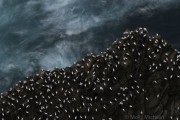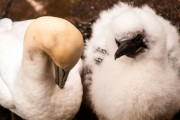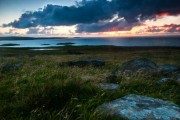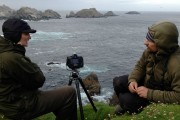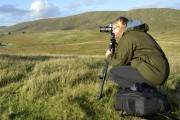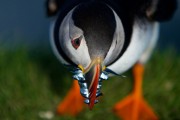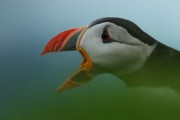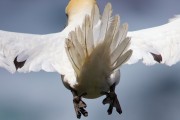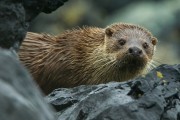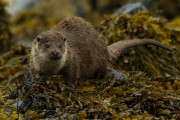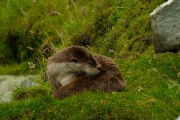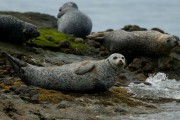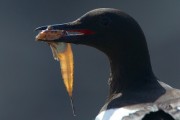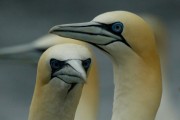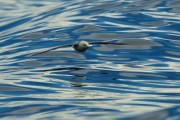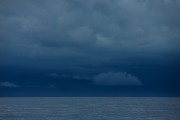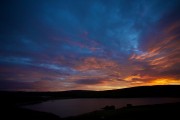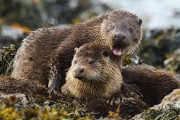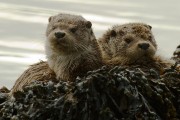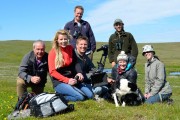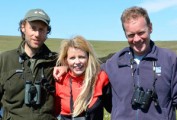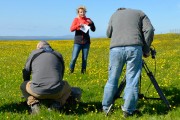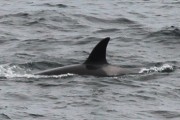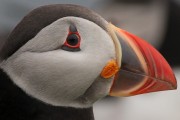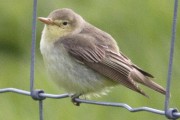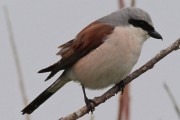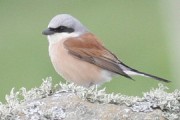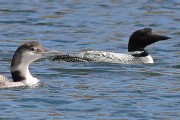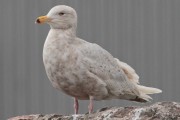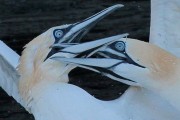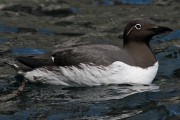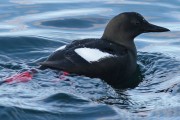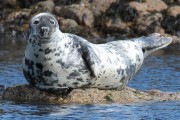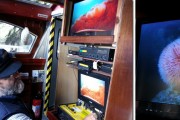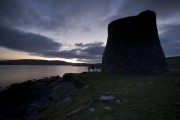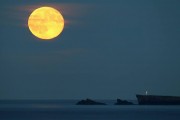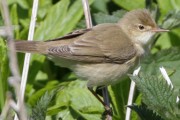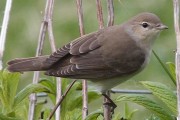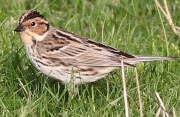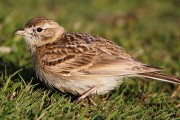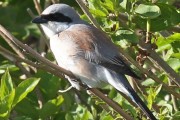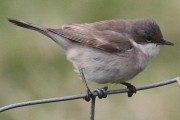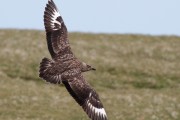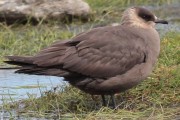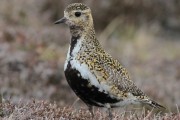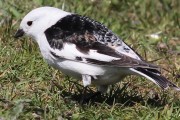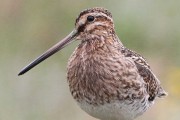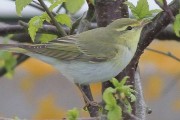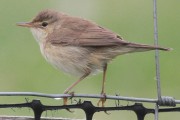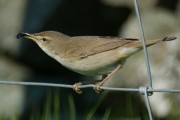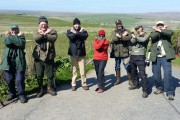Archive for the ‘News’ Category:
Steve Young’s April in Shetland itinerary
Posted by Brydon Thomason on Friday 1st November 2013 | News, Otters
Steve is one of the UK’s best known bird photographers and is a monthly columnist in both Birdwatch and Outdoor Photography magazines. Returning to photograph Shetland for the first time since the days of Snowy Owl on Fetlar and Black-browed Albatross on Hermaness, he reviews his one to one itinerary with me back in April…
19th April
“Aye, it’s only a peerie breeze Stevie; we’ll stroll to Hermaness and see some Maalie and Soalan Gus“. It was dawn at the Shetland Nature Lodge, a howling gale raged outside with rain showers driving against the windows, and Brydon Thomason had just arrived for breakfast…speaking a foreign language…I staggered up Hermaness a couple of paces behind as the wind billowed around my face; the rain had relented, but had been replaced by snow and sleet showers…but then we reached the cliffs…and everything was forgotten at the scene that unfolded before me. Crashing waves, calling birds and Gannets (Soalan Gus) and Fulmars (Maalie) hung in the wind at point blank range for my camera. It was a fantastic morning’s photography and the weather actually made it even better than it would have been on a sunny day. (Peerie means small or tiny and the breeze wasn’t!)
After lunch I was promised Otters…and an hour or so later I was indeed photographing three of them, a mum and two cubs eating a Lumpsucker, so can’t really complain about the guide not delivering, but his late afternoon tea making wasn’t up to scratch although I think it was just a cunning plan to make sure I made the rest.
20th April
Off to Yell today and it wasn’t too long before we had even better views than yesterdays of Otters. A prolonged photographic session followed, that took up most of the day, of three individuals that stayed around the same area for a couple of hours; Black Guillemots also showed well in one of the harbours and the day ended back on Unst with great views of flocks of Long-tailed Ducks flying along the sea.
21st April
Time for a prolonged tour of Unst with the morning spent at a Bonxie colony that was yet to start actual breeding, but up to thirty birds present with a bit of display action and lots of flight photography opportunities. We found the first Whimbrel of the spring and I also managed a few pics of Rock Dove, Oystercatcher and a few more on the Long-tailed Ducks.
22nd April
There are some days when you have to accept that you just cannot take photos and today was one of them with driving rain and gales for most of the day. We spent it sorting through photos and generally messing around with Photoshop and re-charging after a hectic few days.
Late afternoon brightness saw us looking for early migrants, but failing to find anything more interesting than a Chiffchaff….
23rd April
Much brighter for my last day and off to a bay to photograph Turnstone and Purple Sandpiper; good photos of both and of Common Gull over stormy seas, but then an Otter ran out of the waves, started feeding on crabs and everything else was forgotten!
Last afternoon and heading towards the airport, but still time to stop at various sites and photo Eider, Black Guillemot and Guillemot.
My short visit was at an end, but I took home with me some fantastic memories of a truly memorable trip and I also had over five thousand images to sort through… April in Shetland, a great time to visit.
Steve Young
Permalink
The Cape May Warbler at Baltasound – 23/10/13
Posted by Mike Pennington on Sunday 27th October 2013 | Birding in Shetland, News
(Intro by Brydon Thomason)
In a week that had already produced a sterling crop of rarities including Siberian Rubythroat, Isabelline Shrike, Lanceolated Warbler and Red-flanked Bluetail, it was clear that Shetland’s epic autumn was far from over…
Having enjoyed a ‘once in a blue moon’ meal with friends and overnight stay in town, Vaila and I had made it as far as Toft ferry, just over an hour away from home to Unst when I picked up a voicemail, it was Margaret Pennington; “Brydon, Mike wants you to come straight to the old Manse and to bring an American field guide…” To say my heart skipped a beat would be a massive understatement. For a birder of Mike’s calibre to ask for assistance and field guide was unusual to say the least, but an American one – this was huge, clearly this was going to be a day never to be forgotten!
I was just over an hour from arriving on Unst when Mike got through on the phone, informing me of his discovery, an American Wood warbler, the features he had (and hadn’t) seen and the species that were at that point in the short list. But one of the names mentioned especially urged my foot to press harder on the accelarator as I drove north – Cape May Warbler!
Mike shares his account of the epic discovery of the Cape May warbler, which had only reached Europe once before…
Brydon
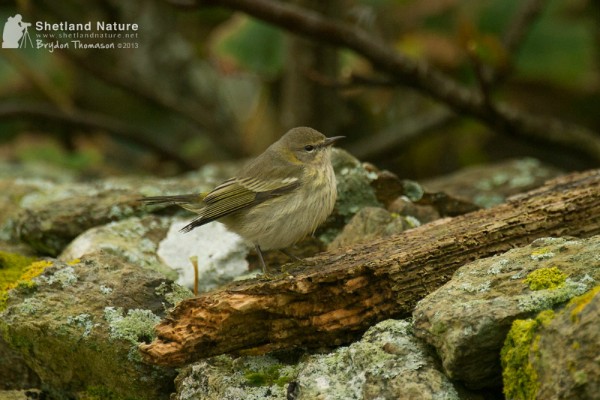
The biggest element in finding a rare bird is surely luck. Perseverance, local knowledge, experience, identification skills – they all play a part – but at the end of the day you have to be in the right spot at the right time when the bird’s showing. On 23rd October, after being away for a few days, I decided to walk round Baltasound rather than drive to the north end of Unst; I decided to head towards the school, instead of heading to Halligarth first as I would usually do; and after checking the lone tree in the Manse garden I stopped for a chat and glanced across to the lone tree again, and noticed a strange-looking bird which definitely required a closer look. Such was the chain of fortune that led to the discovery of a second for the Western Palearctic.
I was chatting to another local birder Dick Foyster, discussing the day’s obvious arrival of thrushes and Blackcaps, when I first saw the bird. From a distance the bird looked vaguely Phylloscopus-like, but it had a big pale patch on the wing. I suggested to Dick that we needed to have a closer look, so we strolled along the road towards the corner of the garden. The bird appeared again on the outside of the sycamore. Incredulously, I realised that this was something extremely interesting: “that’s an American wood warbler!” The bird was on view for a good 20 seconds or so, long enough to realise what we were looking at and take in the most obvious features. This was, however, my best view of the bird for the next four hours!
Over the next hour the bird showed fleetingly in the lone sycamore. Dick had to leave as he had people coming to do work at the house. My phone had no signal. My only attempts at taking a photo had captured some out of focus leaves. I could get very little more on the bird. Then it left the sycamore and headed to a small patch of nettles. By the time I got there, there was no sign of it. I returned to the sycamore – no sign. A bird flew past and I chased it – it was a Blackcap. Two more Blackcaps were chased down. It looked as though it had gone and I still had no photos and only a cursory description.
I’ve never been in this situation before, but faced with a Setophaga (they’re not Dendroica any more, remember), and one without obvious bright colours on it, my thoughts have always been start with Blackpoll Warbler and work from there. Some of the features seemed good for Blackpoll: streaked underparts, fairly plain face, two wing bars, pale tertial fringes, white undertail coverts, some white in the tail. But the wing bars seemed odd – from a distance they looked more like a pale wing patch, and only close up was it obvious that there were two bars. And wasn’t Blackpoll a brighter bird? This was a very dull greyish-olive bird. There was something of Yellow-rumped Warbler in the plain face and streakiness, but there seemed to be no obvious yellow in the plumage (I hadn’t seen the greenish rump or yellowish primary fringes at this stage). The bird did remind me of Cape May Warbler,which I had seen in Cuba. But surely not – I knew that there was only one British record and that was in spring. It seemed that I might have something really, really good, but I still didn’t have enough to be sure.
I decided to check the lone sycamore in the Manse garden once more before widening my search, and to my relief the bird had returned. This time I was determined to get photos as most views so far had been too brief to get any more detail than I already had. Eventually I grabbed a few poor photos in the worsening weather – it was definitely getting foggier all the time – before the bird left the sycamore and headed determinedly towards the old church at Hillside. The photos revealed one feature I had not yet seen in the field: a bright green neck patch.
At this point my wife Margaret arrived after Dick Foyster had phoned her. She brought two vital items – a copy of Sibley and a mobile phone on another network. I looked through the field guide. Could it be a really dull Blackpoll with dark legs? Check the other species. Nothing fits – except my long shot of Cape May Warbler – there was that greenish neck patch on a dull greyish-olive bird! This was a big, big call and I really, really wanted someone else to see it. I was pretty sure it had to be a Cape May Warbler, but it was massive leap of faith to actually believe it!
I phoned Brydon Thomason who was on his way back home to Unst but would not be back for over an hour. Then I phoned Paul Harvey and told him I had a Dendroica (yes, I know I should have said Setophaga). As Paul was Shetland year-listing I knew he’d come even if it was ‘only’ a Blackpoll, but I asked him how I would separate Blackpoll from Cape May Warbler. Mantle and leg colour were suggested. Dark legs and plain mantle pointed towards Cape May Warbler again! We decided to put out news on the local grapevine, without a definitive identification for the moment, to give people the chance to come for it. I decided to try and relocate the bird and stay with it until help arrived.
Margaret and I headed down to the old church at Hillside, where there is a small garden holding two or three sycamores. We saw the bird almost immediately, but it was as furtive as ever, mainly revealing itself when chasing off a Chiffchaff and a Blackcap that dared to enter the trees. Just before Brydon Thomason arrived, though, it started feeding off the walls around the small garden. This meant that Brydon got good views and more photos almost as soon as he got there. The bird even started calling in flight – a sharp tsip, almost reminiscent of Song Thrush or a rare bunting. Brydon had also brought a copy of Kaufman (which depicts a very dull Cape May Warbler) and he too went through the process of elimination via the field guides. Conclusion, it had to be a Cape May Warbler.
Now that it was conclusively identified the bird suddenly decided to stop hiding and started feeding along the wall behind the sycamores. Whereas I had never seen it perched in one place for more than a few seconds before, it now sat in full view on the wall. It was only now that I finally saw the bright greenish rump and the yellowish fringes to the remiges, but we could also see the greenish neck-patch, which was only visible at some angles, and the broad fringes to the greater coverts that produced the wing-panel that was so obvious at distance. Paul Harvey and a few other observers arrived soon afterwards, and about 20 or so people made it up from Mainland Shetland before dark. The next day more than 60 people saw the bird, with the highly novel sight of five aircraft parked on the apron at Baltasound airstrip.
It was only after it went dark on the first evening that the enormity of the find sank in. This was not just a second for Britain, but it was only the second for the whole of the Western Palearctic. This is a species that has not even turned up in the Azores. This is a species that has never been found in autumn anywhere on this side of the Atlantic, the previous British record involving a singing male in spring, found by Tom Byars and Iain McDonald in Paisley Glen, near Glasgow, on 17th June 1977. It may not be a first for Britain, surely every rarity-finders Holy Grail, but this was just as good in my eyes.
Finally, a thank you for the good-natured manner of the visiting birders and for following the advice put out via the Nature in Shetland website. Unst has not seen anything like this before and most residents actually enjoyed the novelty of the occasion. But there is a way of further showing your gratitude for the hospitality enjoyed by many birders in Shetland in recent years. We may not go around rattling a donations tin, but there is a modern alternative, and Shetland Bird Club has set up a Just Giving page to raise money for MacMillan Cancer Support at www.justgiving.com/Shetland-Bird-Club. So, if you twitched the Cape May Warbler, or the Pine Grosbeak, or the Thick-billed Warbler, if you came for a birding holiday, if you enjoyed a warm welcome, exemplified by the friendly sign at the Mid Yell Subalpine Warbler, please consider showing your gratitude by supporting this charity, which does sterling work in Shetland.
Mike Pennington
Permalink
Photography Workshop review; Autumn on Shetland – Nature, light & land
Posted by Molly Michelin on Wednesday 18th September 2013 | News
Returning to gain work experience for her second time this year, Molly Michelin (studying Marine & Natural history at Falmouth University) summarizes our debut landscape and nature photography workshop collaboration with Richard Shucksmith of Earth in Focus. Although not completely full, the workshop went very well, providing some wonderful opportunities for our guests to capture exciting images of Shetland in this special season.
A big thank you to guests Lauren Cooney and Ruth Asher for sharing their wonderful images from their week with us…

With its endless photographic opportunities, Shetland is a dream location for wildlife and landscape photographers. A remote archipelago at the mercy of the North Sea & the Atlantic, the islands are alive with wild, untamed landscapes that are molded by the ever-changing weather and light. With light forming the base of photography, working with it to create some outstanding imagery was the aim of the week for the workshop guests.
Designed to explore both the landscapes and wildlife of Shetland the workshop is led by Richard Shucksmith & Brydon Thomason. This collaboration gave the guests guidance in both fields of photography, Richard’s experience and knowledge of landscapes allows him to capture the raw untamed landscapes coupled with dramatics skies in the most breathtaking ways, meanwhile Brydon’s natural affinity with the wildlife and the islands leads to some of the most intimate and personal wildlife encounters.
A rather wet start to the week did little to dampen the enthusiastic spirits of the guests; kicking of the week with a trip to Yell to collect camera trap footage from an active otter site gave the guests an early glimpse into the lives of Shetlands illusive otters. Brydon and Richard regularly make use of the Bushnell camera traps to help them identify patterns in movement and activity of the otters. Rain never lasts that long on Shetland and landscape photography was at the forefront of our agenda; dark clouds and high levels of water movement made for some dramatic moody imagery. Once darkness had fallen and a hearty meal back at the lodge there was time to work on photographic workflows and post processing using software such as Lightroom. Essential elements to help bring out the best in any photographers work.
The third day brought the group a wildlife encounter to remember, news quickly spread about a pod of 30+ long-finned pilot whales that had been sighted in Firth’s Voe, Mainland. This was not to be missed; we headed of hoping we would reach the whales before they left the voe. Driving from the lodge in on Unst, one of the most northerly points on the islands, we headed south knowing it was a good hour and two ferry journeys before we would get to where the whales were. A quick chat with Mark Chapman who had originally sighted the pod at around 10.30am confirmed they were still there. Excitement was brimming as we drove across Yell. On reaching the yell ferry a call from Gary Bell also confirmed they were still there, it looked like we might make it. By midday we were on the shoreline alongside a growing crowd of photographers, ecologists and local wildlife lovers. This encounter gave us the opportunity to photograph and witness cetaceans in close proximity, with the whales only 30metres off shore, at times you could hear vocalization within the pod. It was an amazing the experience but concerns were being voiced due to their behavior that the pilot whales may strand themselves as they headed right into the shallow end of the voe. Pilot whales have been known to strand in the past for various reasons. With this risk in mind, a boat was deployed to help drive them out into deeper water which was successful. Photographing, filming and just observing these whales is something I’m sure none of the group will forget.
As well as the amazing wildlife encounter this day also brought us to mighty the cliffs of Eshaness, a place brimming with photographic opportunities. The ever-changing weather tested the photographers, who worked with filters and long exposures to create atmospheric images of the rugged cliffs and Eshaness lighthouse that have stood the test of the raw power of the sea crashing upon them. Working into the evening meant we were shooting with fading light moving along to different points on the cliff tops allowed us to capture the lighthouse in a variety of compositions before a late return to lodge.
The next day back on Unst saw a trip to a beautiful beach to photograph seascapes and waders. I had spent some time photographing the waders on the beach earlier on in my trip, and after achieving some success it was decided that as a group we would go and work on photographing the sanderling and dunlin that flock to the tide line to forage. This week really benefited from the small number of individuals on the workshop. Time could be spent thoroughly working on helping them to achieve the shots they were aiming for, slowing down the process, looking at capturing interesting behavior and minimalistic portraits.
Otters were also on the agenda for today, with SE winds, it was decided that we would visit an active shoreline but before we had even left Unst we came across an individual fishing. After spending time with this individual we then continued to the next site where we were lucky enough to spend time with six different otters, with a mother and her two cubs being the highlight of the day. Brydon’s deep love and understanding of the islands otters enabled us to have some outstanding close encounters without the otters ever knowing we were there. Utilizing local knowledge, the wind direction and tides, the guests were able to enjoy photographing and observing the family as they fished, played and slept along the shoreline. At times you just didn’t know which way to look!
Hermaness is a location that offers opportunities for all different aspects of photography, whether that is landscapes or wildlife, spending a day on the cliffs hardly scratches the surfaces of the endless images you could capture. After spending several days working on photographing the puffins & gannets on the cliffs during my visit in June, and after coming away from those sessions, I had to started work on ideas for new shots that I wanted to produce. I think of one the strongest emotions I felt upon Hermaness was the sheer power of the sea below you, peering over the edge towards dark platforms crowded with hundreds of white specs, these two elements brought together were key to the shots I was hoping to achieve this time around. Today was also yet another great day for cetaceans with Rissos dolphins being spotted from the cliffs (while we were shooting Muckle Flugga Lighthouse) as well as Minke whale passing through. There is an immense amount of landscape opportunities on Hermaness and it was great to be able work on some many different elements of photography, including mixing gannets with landscapes, thus creating a striking landscape images showing the gannets in their environment. Having two tour leaders allowed for the group to split as one half headed back to the lodge while the other half stayed till dark to capture the famous Muckle Flugga lighthouse light coming on and to add that extra element to the image.
After 5 days of exploring the landscapes and wildlife of Shetland, the last full day was upon us, with amazing light, rolling sunshine amidst soft fluffy clouds we decided to split the day, continuing with landscape work as well as working with otters again. Both aspects brought great success, another ‘otterly’ brilliant day, spending time with 5 otters, giving the guests another fantastic opportunity to take away some amazing images of these signature species of Shetland. The evening’s landscape location was the breathtaking view across the ness of Collaster along the west coast of Unst. This location gave the photographers the chance to use the derelict old croft buildings as a subject within their images, experimenting with a range of lenses enabled them to capture these ruins in a variety of ways, the vast expanses lend themselves to the wide angle lenses, meanwhile, focusing in on the crofts beneath the towering hills of Valla field create a striking size comparison image.
With a week of outstanding photography, learning and a lot of laughs coming to an end, it was time to head back down south to Sumburgh. Along the way visiting a variety of different locations to take in more of the breathtaking landscapes Shetland has to offer- finishing up with an amazing close encounter with a Minke whale off Sumburgh Head. What an incredible week!
To find out more about this unique Landscape and Nature photography collaboration workshop see dates and details in our holiday program.
Guest recommendations
I had never been to the Shetland Isles before until I joined this “Autumn on Shetland” workshop. As a keen amateur landscape photographer I was really looking forward to new places to capture and I wasn’t disappointed by the amazing seascapes we were presented with. But it wasn’t just the striking landscapes that made this holiday, there was an abundance of wildlife which we had the opportunity to capture too. One day we were watching a pod of Pilot whales and the next we were tracking otters not to forget the amazing Gannet colonies at Hermaness. Brydon, Richard and Molly made for a fantastic team with their amazing ability to locate wildlife particularly the sea otters getting us into close proximity to capture these endearing creatures. After long days out in the field we were returned to the comfort of the Shetland Nature Lodge (our accommodation for the week), a modern, spacious and newly renovated crofters cottage which offered fantastic views out onto the bay where we could watch, from the comfort of our armchairs, Gannets diving for food. This was a fantastic experience and one which I will never forget, I made some great friends and returned home with a fantastic set of pictures. A very big thank you to Brydon, Richard and Molly for making this such an amazing experience.
Ruth Asher
I have had the good fortune to travel in a lot of places in this amazing world we live in, and can easily say that time with Shetland Nature is one of the best holidays I have ever had! It is not only the stunning scenery, amazing wildlife and wild spaces of Shetland that made this holiday so special. The commitment, passion and knowledge of Brydon Thomason and Richard Shucksmith, as well as their true desire to share this passion and knowledge with their guests, in a patient, fun, natural, easy-going way, make the experience unbeatable. Also in this case we were lucky enough to have the equally friendly and helpful Molly Michelin with us, a university student on internship with Shetland Nature.
I was very much a ‘beginner’ with my photography, and had a great time learning new techniques and about the amazing places and wildlife Shetland has to offer. Having both Richard and Brydon as guides was great, both ever willing to provide support and useful tips, as was Molly and my fellow guest, Ruth! I never thought I would come away with the sort of shots I managed to take, and yet I did! I am even more excited and interested in photography now that I see what I can do!
Brydon and Richard enlightened me to the world of otters too. On the two days we went out ‘ottering’ we saw many otters. We managed to watch them in their natural habitat for quite a few hours each time, with Brydon, Richard and Molly ensuring that we did so in a way that was not disturbing to the otters, a commitment they take very seriously. Such a special experience that I feel privileged to have experienced.
Finally, what has to be said is these guys are all just great fun, – a lot of laughs and hilarity throughout the week, but seriously, these guys know their stuff. I will definitely be going back, and am pushing all my friends to do the same!
Lauren Cooney
Permalink
A visit from Italy – early August bespoke photography itinerary…
Posted by Brydon Thomason on Monday 2nd September 2013 | News, Otters
Here’s a short piece accompanied with images from Italian photographer Mauro Mozzaerelli who had bespoke photo itinerary with me in early August. His images are a fine example of a one-to-one itinerary, which is becoming very popular for us. This year alone we have welcomed photographers from all over the world from as far as France, Switzerland, Germany, Canada, Italy, Slovakia and many others.
Mr. Brydon Thomason – the Otter whisperer
As a seasoned traveller and photographer, every time I start a new wildlife trip, I always try to keep my expectations low (as low as possible…). Well, no need to worry this time! The great knowledge and respect for the wildlife (very important for us) of Mr. Thomason made our trip to the Shetland Islands an unforgettable one.
We didn’t expect to be able to find so many Otters in daylight, and we had the privilege to spend many hours with them and enjoyed many encounters (it really is incredible!).
The windy early morning at the Hermaness Nature Reserve was something to remember with spectacular opportunities of Puffins, gannets and Great Skua.
Shetland is a very special place and, thanks to Mr.Thomason, we had a very special trip! Thanks again Mr. Thomason and thanks Shetland Nature!
Mauro Mozzarelli & Minnie Trenchi (Rivergaro – Italy)
• View more of Mauro’s images from his time with us at http://mmwildlife.zenfolio.com/
• Find out more about bespoke one-to-one photo assignments with Shetland Nature.
Permalink
Otter Awareness Day Fundraiser for IOSF
Posted by Brydon Thomason on Wednesday 24th July 2013 | News, Otters
Wow, where does the time go?! It is now nearly two months since we initiated and organised a ‘Sponsored Otter Search’ to raise money to support the International Otter Awareness day, on the 29th May, organised by the International Otter Survival Fund.
A combination of our busiest season to date and collecting and transferring sponsorship money has meant that we are only now posting news on this fun and exciting event back in May. We were amazed and genuinely delighted at the response and support we had with our Sponsored Otter search when between the three of us; myself, Gary Bell and Richard Shucksmith we saw 25 otters.
In total we raised £800 and would like to thank each and for their generosity in supporting us through donation/sponsorship.
This money we raised for ‘Otter Awareness Day’ is being used to repair and replace some of the facility on Skye where rehabilitated otter cubs are looked after and the larger moorland pens they are moved to when older and more independent as part of their journey to eventual release. They are in them for several months and can be very destructive! They have experienced the added problem recently of a wild otter trying to dig his way into the pens!
As well as this our annual ‘corporate sponsorship’ funds are channelled into the great education work the IOSF do (Paul and Grace go to schools, clubs, societies etc to give talks about otters to raise awareness).
They are also working at the moment on setting up a UK wide alliance to bring all the otter groups together under one umbrella so that we have a degree of national coordination with standardised surveying methods etc. Money raised from our standard adoptions (rather than corporate) tends to go straight towards the care of the otters at the sanctuary.
For more information on the IOSF please visit http://www.otter.org/ to find out how you can help.
Permalink
BBC1’s Countryfile on Shetland
Posted by Brydon Thomason on Friday 12th July 2013 | News, TV Appearances
Tune into BBC1’s Countryfile this Sunday the 14th July if you want to top up with a taste of Shetland…
It was great to be asked to help out and feature on the programme and I was delighted to be involved. I was especially proud, (though quite nervous on screen!), as the lead story was Fetlar, in particular the project being carried out by RSPB on the islands Red-necked Phalaropes by fitting geo-locaters to determine where these beautiful birds winter, amongst other data the devices may reveal.
They filmed me talking to presenter Ellie Harrison about growing up on the island, my passion for nature and in particular my love of Otters throughout Shetland. Although they were not able to be out and work through the time I suggested as the best time for finding Otters and their time was limited, we did manage an encounter and it was nice to talk a little about them.
The Phalaropes performed wonderfully too, which was the icing on the cake for them and tied in fantastically with local RSPB warden Malcie Smith’s guidance, who few could match when it comes to knowing these delightful little Arctic wading birds.
The crew were fantastic to work with and it was an exciting and enjoyable day all round – we were immensely lucky with the weather, beautiful blue skies with not a cloud in sight, good banter and some good encounters!
Permalink
Shetland Spring Birding May – June 2013
Posted by Martin Garner on Tuesday 9th July 2013 | Birding in Shetland, News
“Quick – grab your bags” was how the spring 2013 holiday began. No time for gentle introductions – a pod of Killer Whales had just been spotted off Sumburgh Head by Brydon, who was leading a photo-tour. Once disbelief had been quelled, it was all aboard the bus for the dash to try and see them! With a little help from friends and team effort, we got everyone up just in time- the week could not have got off to a better start! Our first seabirds such as Puffins, Guillemots and Razorbill offered a fine supporting cast. Pumped up with adrenaline, all guests were happy to press on for a couple of hours birding before dinner. We left the Orca pod to try to see a beautiful female Red-necked Phalarope at nearby Spiggie with a bathing ‘club’ of about 40 Great Skuas (Bonxies) as a backdrop. While watching the phalarope some of the group turned around only to find an Icterine Warbler on the fence-line; the first record of the spring for the isles (away from Fair Isles). Superb! We were already finding our own good birds. The 1st summer Ring-billed Gull was still present on Loch of Hillwell plus a host of fresh water birds and a Glaucous Gull. It’s fair to say the first couple of hours of this holiday had more than met expectations!
The next morning heralded our next ‘find’. A quick scan around Sumburgh farm revealed not one but 2 Red-backed Shrikes; a male recently present plus a new female with striking rich brown plumage. While watching the shrikes we also picked up Iceland Gull, Long-tailed Duck, Black Guillemot and Great Northern Diver.
Lerwick harbour was our mid-morning destination. A migrant male Pied Flycatcher in towns gardens proved birds can be found anywhere in Shetland but a Canada Goose at Clickimin Loch drew much more attantion. While the same size as 2 accompanying Canada’s, its darker, browner plumage with no white neck collar indicated its identity as a possible Todd’s Canada Goose – a vagrant bird form North America (and potential first for Shetland). Intrigued (and with sequence of images nailed) but somewhat distracted by our sailing time commitment for our boat trip to Noss, we only just made the pier in time for the spectacular trip on board the Dunter out to the seabird colony at Noss.
Another Glaucous Gull in the harbour plus summer plumaged Red-throated and Great Northern Divers bejewelled our journey.
Once there, the seabird cliffs provide a breath-taking spectacle yielding the kind of point blank views not usually possible with Gannets, Puffins, Razorbills and Guillemots plus lunch stealing Bonxies alongside the boat. Afternoon was spent taking spectacular scenery of east side of the South Ness including the tombolo at St Ninian’s Isle. We also found (another!) male Red-backed Shrike at Spiggie.
A rest around teatime prepared us for the late night outing to the magic of the Island of Mousa and the Storm Petrels. Famously described as the ‘sound of a fairy being sick’, the enchanting purring song of the petrels in the majestic and mysterious ancient broch created an unforgettable memory.
Bound for Unst we began Sunday morning with a Short-toed Lark on Sumburgh Head with awesome views of Puffins nearby. Britain’s most Northerly Island was a place of exploration and discovery for the next few days.
It was here on Unst that we had what was to stand out as one of the most favoured memories (among many) of the week’s holiday. So let’s fast forward:
Team effort is a key element for Shetland Nature holidays, both within our groups, amongst fellow team members and residents around the isles. Tuesday afternoon was the perfect example…. Unst resident Robbie Brookes contacted us to say he’d seen an acrocephalus Warbler at Skaw that he thought was probably a Marsh. We knew this was worth checking and arrived at Skaw to banks of mist rolling in on NE breeze; oow, special conditions indeed. We soon located a Garden Warbler, a Spotted Flycatcher and another bird ‘flew’ in’ to join them but remained obscured. With a little effort we were soon having great views of a spring Marsh Warbler and discussing the key ID features.
Just beyond up popped a female Red-backed Shrike. Fantastic! 2 minutes later another Red-backed Shrike, both on view at the same time.
Hold on – fog, north-east winds… now we’re cookin’. In the next half hour we found 6 Spotted Flycatchers and a Lesser Whitehroat. Then the icing on the cake: 2 of our guest returning from the beach said a couple of birds had been flitting about on the stream. Any bird that’s perhaps not familiar or appeared unusual is not to be left in Shetland and in these conditions…a quick stroll down and BOOM! a Little Bunting; regular but still a good find in autumn but very rare in spring. What a stunning bird and a life tick for most of the group.
Against this peak birding moment in Unst we savoured the majestic Hermaness with oodles of Bonxies, singing and displaying Dunlin and Golden Plover, another majestic seabird cliff, stunning spring Snow Buntings on Hermaness and Lamba Ness, Arctic Skuas and Arctic Terns.
Haroldswick scored for us too with migrant Wood Warbler, Greenland and Mealy Redpoll with a Quail in the same ‘ditch’, and the injured 1st summer Common Crane. Baltasound yielded migrants too including Long-eared Owl and Cuckoo and Otters on an early morning safari.
Our day trip to Fetlar always seems to produce something special. This time a Blyth’s Reed Warbler no less, found by SN team member Andy Cook – only the 7th May record for Britain! Redstart, Short-eared Owl and Siskin were all migrants and we found another Red-backed Shrike!
Like book ends, the last day of the holiday was marked by surprises which included rare birds and cetaceans. We got to be in on the identification wrestle with a typically and frustratingly elusive Thrush Nightingale at Virkie, another SN team member find, this time by Rob Fray and finished before dinner by finding 2 Minke Whales passing north off Sumburgh Head.
Space and words in a report like this make it impossible to shoehorn in, all of the wonderful experiences and discoveries we had. Suffice to say it was such a starlight holiday – we are already planning next spring’s gig, with a special guest guide Tim Appleton a ‘new addition’ to the Shetland Nature team.
And if you can’t wait that long, there are still places for this autumn birding holiday adventures!
Permalink
Spring News
Posted by Brydon Thomason on Thursday 7th March 2013 | News
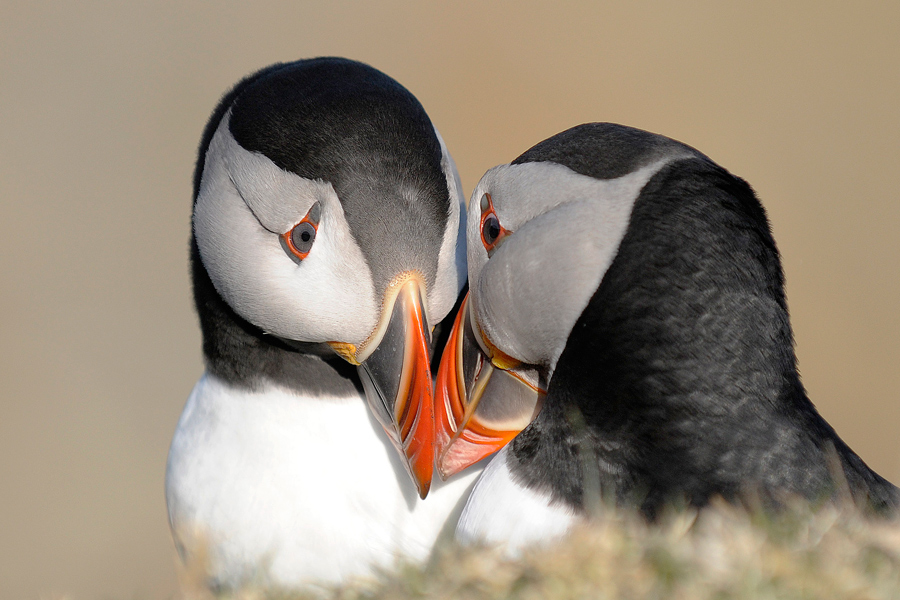
Tammie Nories Together. Photo by Brydon Thomason
Dear Friends of Shetland Nature, we hope all is well with you as we enjoy the first stirrings of spring.
This is, as per previous seasons, our busiest period of the year for interest in our programme of holidays and booking enquiries. Just over the past week for example we have seen several of our dates filling so just so as to hopefully avoid any disappointment for anyone who has been undecided, we wanted to share an update on this season.
I’d like to also share my new photography Facebook page with you and very much hope you will find it interesting, please ‘Like’ it and following my posts which are solely Shetland based. The aim is to share and promote my own photography, projects I am working on and communicate my passion for Shetland’s natural history. Through this page, which I intend to compliment activity on our Shetland Nature Facebook page and our website and also make interested photographers aware of workshops, hides and itineraries that I am working on.
Warm wishes and kind regards,
Brydon Thomason
Permalink


